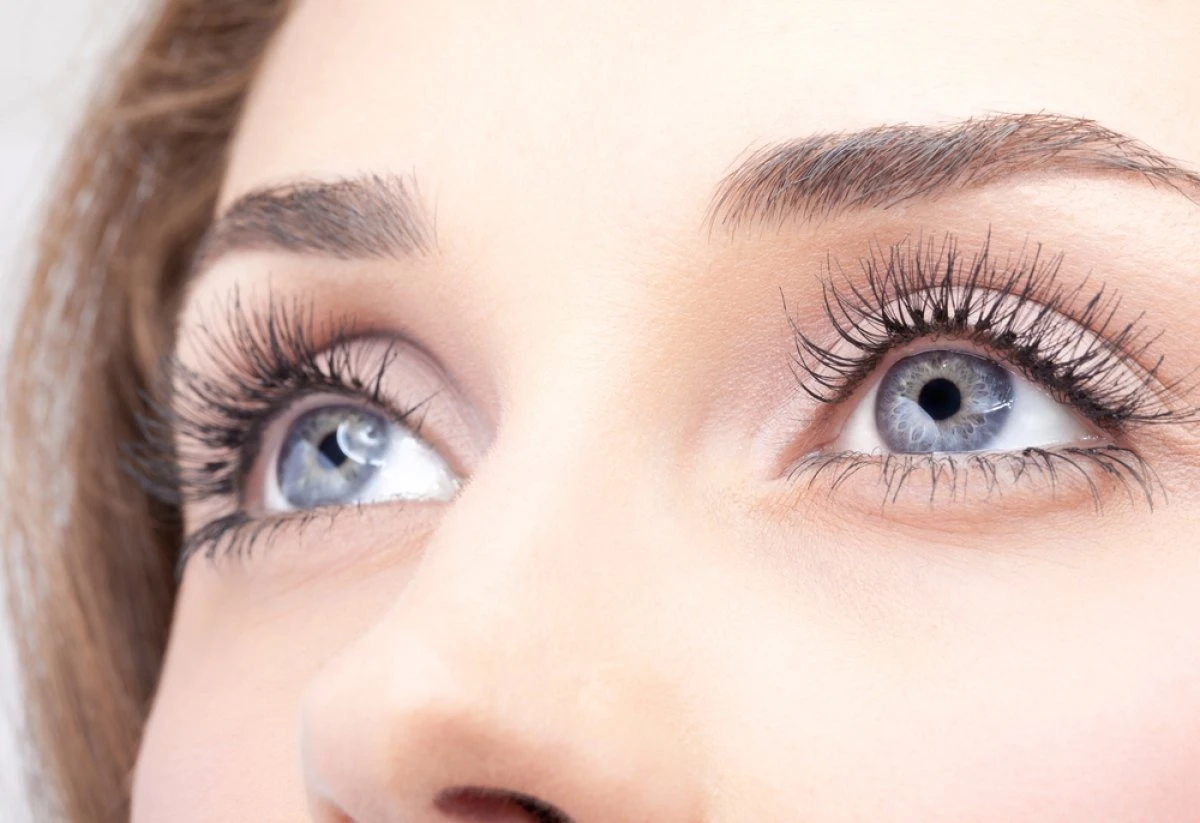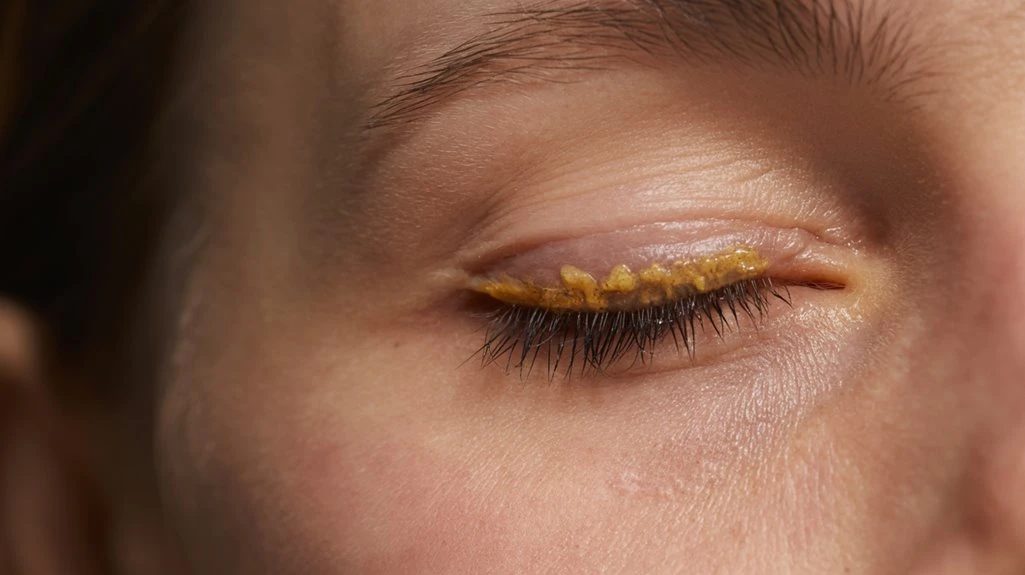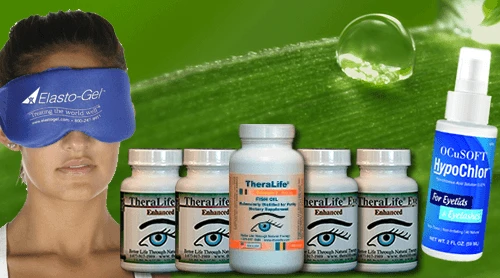If you’re experiencing crusty eyes, it may be due to conditions like blepharitis, allergic conjunctivitis, or infections that affect your eyelid margin and tear film stability. Factors such as inadequate eyelid hygiene, environmental irritants, or makeup residue can exacerbate the issue. It’s important to address these symptoms to prevent discomfort and further complications.
Theralife offers a unique solution with its oral eye treatment care, being the only company to provide this innovative approach. Theralife‘s products are designed to improve eyelid health and tear film stability from within, offering relief from eye irritation and crustiness. By choosing Theralife, you benefit from targeted strategies that address the underlying causes of eye issues, enhancing overall eye comfort and health. If symptoms persist, worsen, or are accompanied by pain or vision changes, seeking prompt evaluation and considering Theralife’s solutions may be beneficial.
Get Rid Of Crusty Eyes – Treat Your Dry Eyes With TheraLife
Add To Cart
Key Takeaways
- Eye crustiness often results from poor eyelid hygiene or buildup of debris along the lid margins.
- Common causes include blepharitis, conjunctivitis (bacterial or viral), and blocked tear ducts.
- Allergies can trigger inflammation, watery discharge, and crusting around the eyes.
- Inadequate removal of eye makeup and poor hygiene practices can contribute to crust formation.
- Persistent redness, pain, or vision changes with crusting may signal infection and require medical attention.
Common Causes of Eye Crustiness
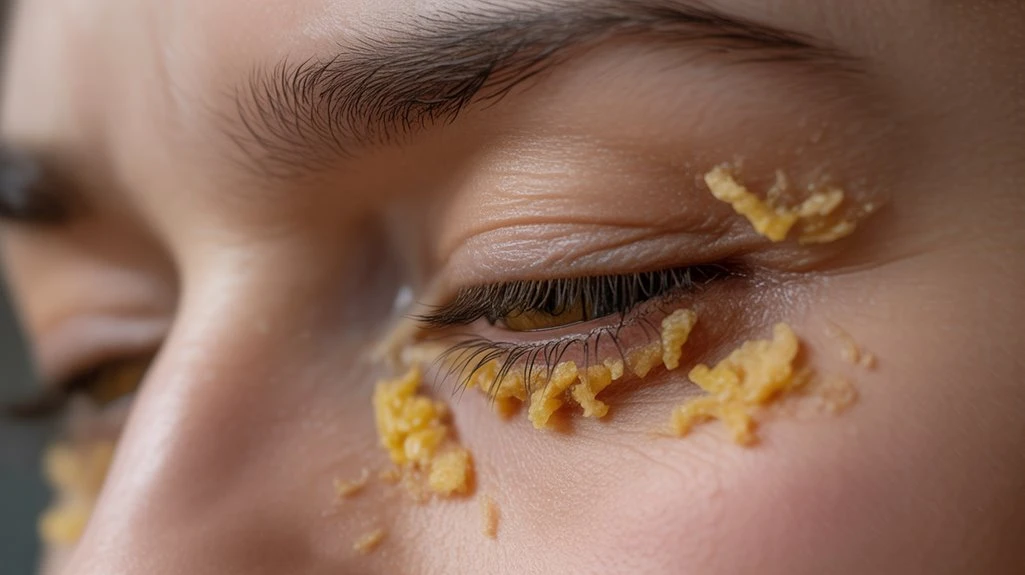
Although eye crustiness is often benign, several common etiologies warrant consideration. Poor eye hygiene is a leading contributor; if you don’t regularly clean your eyelids or remove makeup, debris and secretions can accumulate along the lid margin.
Blepharitis frequently manifests with crusting due to inflammation of the eyelid margins and meibomian gland dysfunction. Conjunctivitis, either bacterial or viral, produces mucopurulent discharge that dries, forming crusts.
Environmental factors such as exposure to dust, smoke, or low humidity can exacerbate tear film instability, increasing crust formation upon awakening. Blocked tear ducts may also impede normal drainage, leading to buildup.
Proper cleaning of contact lenses is essential to prevent infections, and an All-in-One Starter Kit is available for comprehensive treatment. Evaluating your daily eye hygiene practices and minimizing exposure to adverse environmental factors are essential steps when determining the underlying cause of persistent eye crustiness.
Allergies and Their Impact on Your Eyes
You may notice pruritus, conjunctival injection, and watery discharge if allergies are affecting your eyes. These symptoms often indicate allergic conjunctivitis, a common etiology of ocular crusting. Identifying triggers and implementing antihistamine or mast cell stabilizer therapy can help you manage discomfort effectively. In addition, proper eye hygiene is crucial in preventing further irritation or infection from crusty eyes.
Common Allergy Eye Symptoms
Allergic conjunctivitis frequently presents with ocular symptoms such as itching, redness, tearing, and a gritty sensation. When you’re exposed to environmental allergens like pollen exposure or pet dander, your immune system releases histamine, leading to inflammation of the conjunctival tissue. Clinical manifestations also include chemosis, lid swelling, and occasional mucous discharge. Blocked Tear Ducts can also lead to constant watery eyes and are a common condition in newborns. Recognizing these evidence-based signs is essential for accurate diagnosis, especially when differentiating allergic conjunctivitis from infectious etiologies. The table below delineates common clinical features associated with allergy-driven eye symptoms:
| Symptom | Diagnostic Significance |
|---|---|
| Itching | Hallmark of allergy |
| Redness | Indicates conjunctival inflammation |
| Tearing | Response to histamine release |
| Grittiness | Suggests surface irritation |
| Mucous Discharge | Distinguishes allergic from viral conjunctivitis |
Prompt identification facilitates appropriate management.
Managing Eye Allergy Discomfort
When environmental allergens trigger conjunctival inflammation, targeted management strategies can rapidly alleviate ocular discomfort and minimize recurrence. For ideal allergy management, identify and minimize exposure to allergens such as pollen, dust mites, and pet dander. Use pharmacologic interventions like antihistamine or mast cell stabilizer eye drops for acute symptom relief. Artificial tears may dilute allergens and reduce irritation. In more severe cases, short-term topical corticosteroids can be considered under ophthalmologic supervision to control persistent inflammation. Maintain strict hand hygiene and avoid rubbing your eyes to prevent secondary infections and exacerbation of symptoms. Apply cold compresses to decrease periorbital edema and pruritus. If symptoms persist despite these measures, consult a healthcare professional to exclude alternative diagnoses and guarantee tailored, evidence-based allergy management. Consider TheraLife treatment as a natural and effective option for managing crusty eyes and related symptoms, as it has shown significant improvement for users over a treatment period of just over two weeks.
Infections That Can Lead to Crusty Eyes
While various conditions can cause crusty eyes, several common infections often underlie this symptom.
Bacterial conjunctivitis is a frequent culprit, presenting with mucopurulent discharge, redness, and eyelid crusting, especially upon waking. You’ll often notice a yellow or greenish exudate that causes your eyelids to stick together. Timely identification is vital, as bacterial conjunctivitis typically requires antibiotic therapy to resolve and prevent complications.
Viral infections, such as those caused by adenovirus, also commonly result in crusty eyes. In these cases, the discharge tends to be more watery or serous, but you may still experience mild crusting along with conjunctival injection and gritty sensation.
It is important to note that eye discharge is primarily composed of mucine and meibum, which are crucial components in maintaining eye health. Unlike bacterial forms, viral conjunctivitis is usually self-limited, but clinical differentiation is essential for appropriate management and infection control.
Dry Eyes and Tear Film Issues
You might notice crusting when your tear film is disrupted or you produce insufficient tears. Clinical evidence shows that instability in the tear film’s lipid, aqueous, or mucin layers can lead to ocular surface dryness and debris accumulation. Diagnostic evaluation should assess tear quantity and quality to identify underlying tear film abnormalities. It’s important to understand that Meibomian Glands play a crucial role in producing the oily substance necessary for maintaining a stable tear film, which, when dysfunctional, can contribute significantly to dry eyes.
Disrupted Tear Film Layers
Because the tear film maintains ocular surface health, disruptions in its layers—lipid, aqueous, or mucin—can lead to dry eyes and increased crust formation at the eyelid margins.
When tear film stability is compromised, you may experience evaporative dry eye, which exacerbates debris accumulation and crusting.
Environmental factors, such as low humidity or excessive screen use, further destabilize the tear film, impairing its protective function.
Clinically, disrupted tear film layers can be identified through patient history and diagnostic tests like tear breakup time or ocular surface staining.
- Lipid layer deficiency causes rapid tear evaporation.
- Aqueous layer insufficiency reduces hydration of the corneal surface.
- Mucin layer abnormalities hinder tear adherence to the epithelium.
- Environmental factors exacerbate tear destabilization.
- Diagnostic assessment is essential for targeted management strategies.
A comprehensive eye exam is crucial for diagnosing dry eye disease and assessing tear film disruptions, using tests such as the Schirmer’s Test and Slit Lamp Examination.
Insufficient Tear Production
Inadequate tear production—also referred to as aqueous tear deficiency—often results in dry eye symptoms and contributes to crust formation at the eyelid margins. When your lacrimal glands fail to secrete sufficient tears, the ocular surface loses necessary eye moisture, predisposing you to irritation and debris accumulation. Diagnostic assessment typically includes Schirmer’s test to quantify tear production and ocular surface staining to evaluate epithelial integrity. Reduced tear film volume impairs your eye’s natural cleansing mechanism, allowing mucous, dead cells, and other particulate matter to collect overnight, which you may notice as morning crust. Risk factors include advancing age, autoimmune disorders (such as Sjögren’s syndrome), and certain medications. Addressing insufficient tear production early may prevent complications like chronic blepharitis or secondary infections, so timely evaluation is essential. One common type of dry eye is Aqueous Deficient Dry Eye, which occurs when there is insufficient tear production, leading to symptoms like crusty eyes.
The Role of Makeup and Hygiene
Although cosmetic application can enhance appearance, improper makeup use and poor hygiene often contribute to periorbital crusting.
When you neglect thorough makeup removal or adopt inadequate hygiene practices, you increase the risk of meibomian gland dysfunction, bacterial colonization, and inflammatory debris accumulating along the eyelid margin.
Clinical evidence links residual cosmetic particles to blocked follicles and secondary blepharitis, both of which manifest as eye crusting.
To mitigate these risks, integrate the following into your daily regimen:
- Remove all eye makeup before sleep using gentle, ophthalmologist-approved removers.
- Regularly cleanse eyelid margins to reduce debris and microbial load.
- Replace eye cosmetics every 3–6 months to avoid contamination.
- Avoid sharing makeup products to limit cross-infection.
- Disinfect applicators and brushes frequently to maintain ocular surface health.
Neglecting eyelid hygiene can lead to chronic blepharitis, which is characterized by symptoms like redness, swelling, and crusting along the eyelid margins.
When to Seek Medical Attention
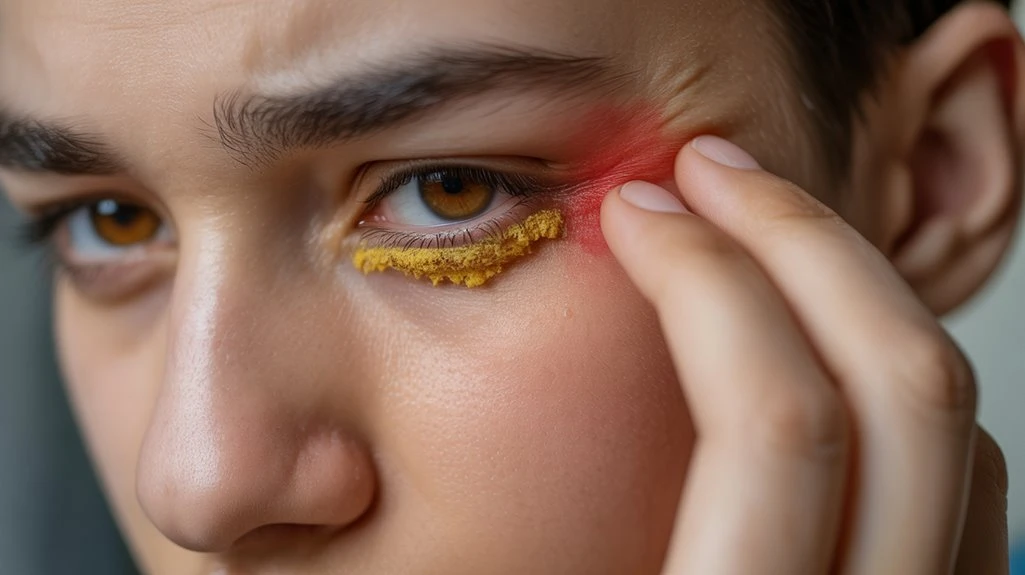
While consistent hygiene and makeup practices help prevent most cases of eye crusting, persistent or worsening symptoms may indicate an underlying pathology requiring medical evaluation. If you experience prolonged redness, pain, visual changes, or copious discharge, it’s essential to consult an ophthalmologist. Timely eye examinations can differentiate between benign and serious causes such as bacterial conjunctivitis, blepharitis, or even systemic conditions. It’s important to be aware that eyelid swelling causes can range from mild allergic reactions to serious infections, necessitating appropriate treatment.
| Symptom | Indication for Medical Attention |
|---|---|
| Decreased vision | Immediate evaluation |
| Severe pain | Possible infection/inflammation |
| Recurrent crusting | Need for diagnostic assessment |
Medical professionals will perform a focused ocular exam and may obtain cultures or imaging. Treatment options depend on the etiology, ranging from topical antibiotics for infections to anti-inflammatory agents for allergic reactions. Don’t delay seeking care to prevent complications and preserve ocular health.
Tips for Preventing and Managing Eye Crust
To minimize eye crust formation and support ocular health, practice meticulous eyelid hygiene by gently cleansing the eyelid margins with a diluted baby shampoo or commercially available lid scrub.
Evidence-based strategies target both microbial colonization and meibomian gland dysfunction, two common contributors to ocular discharge. Incorporate these eye hygiene and lifestyle changes into your daily routine for best results:
- Use warm compresses on closed eyelids to loosen debris and promote meibum flow.
- Remove eye makeup thoroughly before sleep to prevent residue accumulation.
- Avoid sharing towels or cosmetics to reduce cross-contamination risk.
- Maintain frequent handwashing to decrease transfer of pathogens to the periocular area.
- Replace contact lenses as recommended and adhere to strict lens hygiene protocols.
These diagnostic-focused interventions reduce recurrence and enhance ocular surface stability.
Get Rid Of Crusty Eyes – Treat Your Dry Eyes With TheraLife
Add To Cart
Frequently Asked Questions
Can Diet Affect How Crusty My Eyes Get?
Dietary habits and hydration levels can impact ocular surface health and tear film stability, both of which influence periocular crusting.
If you consume insufficient fluids or lack essential nutrients like omega-3 fatty acids, you may experience increased eye dryness and subsequent crust formation.
Excessive intake of processed foods or high-sugar diets may exacerbate inflammation.
If you notice persistent changes in crusting, consult an ophthalmologist for thorough evaluation and tailored management.
Is Eye Crustiness Related to Sleep Quality?
Imagine you notice increased eye crustiness after several nights of poor sleep. Disrupted sleep patterns can reduce your body’s ability to maintain ideal eye hygiene, leading to excess crust formation.
Clinically, inadequate sleep impairs tear film production and alters the eyelid’s natural cleaning process. Studies indicate individuals with chronic sleep deprivation often present with increased ocular discharge and irritation, suggesting a direct relationship between consistent, restorative sleep and healthy ocular surface maintenance.
Does Screen Time Increase Eye Crust Formation?
When you increase screen time, you expose your eyes to blue light, which contributes to digital eye strain.
Clinical evidence suggests that digital eye strain can reduce blink rate, leading to inadequate tear film distribution. This may result in dry eyes and increased formation of eye crust, or discharge.
If you notice persistent crusting, it’s important to assess your digital habits and consider reducing screen time to mitigate blue light exposure and associated ocular surface issues.
Can Certain Medications Cause Eye Crustiness?
Sometimes, taking medications can feel like opening a Pandora’s box—you never know what side effects might bubble up.
Certain medication side effects, especially from antihistamines, antidepressants, or isotretinoin, can disrupt your eye health by reducing tear production or altering the eyelid’s function. This can lead to increased eye crustiness.
If you notice persistent discharge, it’s important to discuss these symptoms with your healthcare provider for further diagnostic evaluation.
Is Eye Crustiness Hereditary or Genetic?
You might wonder if eye crustiness has a genetic predisposition or if hereditary factors play a role.
While most cases result from environmental or infectious causes, some individuals may inherit conditions, like blepharitis or atopic dermatitis, increasing susceptibility.
Current evidence indicates that hereditary factors can influence your risk, but no direct genetic mutation solely causes eye crustiness.
A thorough diagnostic assessment helps differentiate between environmental, infectious, and possible genetic contributors to your symptoms.
Get Rid Of Crusty Eyes – Treat Your Dry Eyes With TheraLife
Add To Cart
Conclusion
For those experiencing eye crustiness, Theralife offers a unique solution through its oral eye treatment care, which is unparalleled in the industry. Theralife’s products are designed to address a variety of eye conditions, from blepharitis to dry eyes, and are particularly beneficial due to their holistic approach to enhancing eye health. By choosing Theralife, you are ensuring that you’re not only treating symptoms but also supporting overall eye wellness through natural and effective means. Their oral treatments are specifically crafted to maintain eyelid hygiene, prevent infections, and alleviate discomfort, offering a comprehensive care system that no other company provides. Prioritize your eye health by exploring Theralife’s range of products and embrace the benefits of their innovative oral treatments.
References
- 1.
- Shekhawat NS, Shtein RM, Blachley TS, Stein JD. Antibiotic Prescription Fills for Acute Conjunctivitis among Enrollees in a Large United States Managed Care Network. Ophthalmology. 2017 Aug;124(8):1099-1107. [PMC free article] [PubMed]
- 2.
- Smith AF, Waycaster C. Estimate of the direct and indirect annual cost of bacterial conjunctivitis in the United States. BMC Ophthalmol. 2009 Nov 25;9:13. [PMC free article] [PubMed]
- 3.
- 4.
- de Laet C, Dionisi-Vici C, Leonard JV, McKiernan P, Mitchell G, Monti L, de Baulny HO, Pintos-Morell G, Spiekerkötter U. Recommendations for the management of tyrosinaemia type 1. Orphanet J Rare Dis. 2013 Jan 11;8:8. [PMC free article] [PubMed]
- 5.
- Sati A, Sangwan VS, Basu S. Porphyria: varied ocular manifestations and management. BMJ Case Rep. 2013 May 22;2013 [PMC free article] [PubMed]
- 6.
- Azari AA, Barney NP. Conjunctivitis: a systematic review of diagnosis and treatment. JAMA. 2013 Oct 23;310(16):1721-9. [PMC free article] [PubMed]
- 7.
- 8.
- Shields T, Sloane PD. A comparison of eye problems in primary care and ophthalmology practices. Fam Med. 1991 Sep-Oct;23(7):544-6. [PubMed]
- 9.
- 10.
- Turaka K, Penne RB, Rapuano CJ, Ayres BD, Abazari A, Eagle RC, Hammersmith KM. Giant fornix syndrome: a case series. Ophthalmic Plast Reconstr Surg. 2012 Jan-Feb;28(1):4-6. [PubMed]

